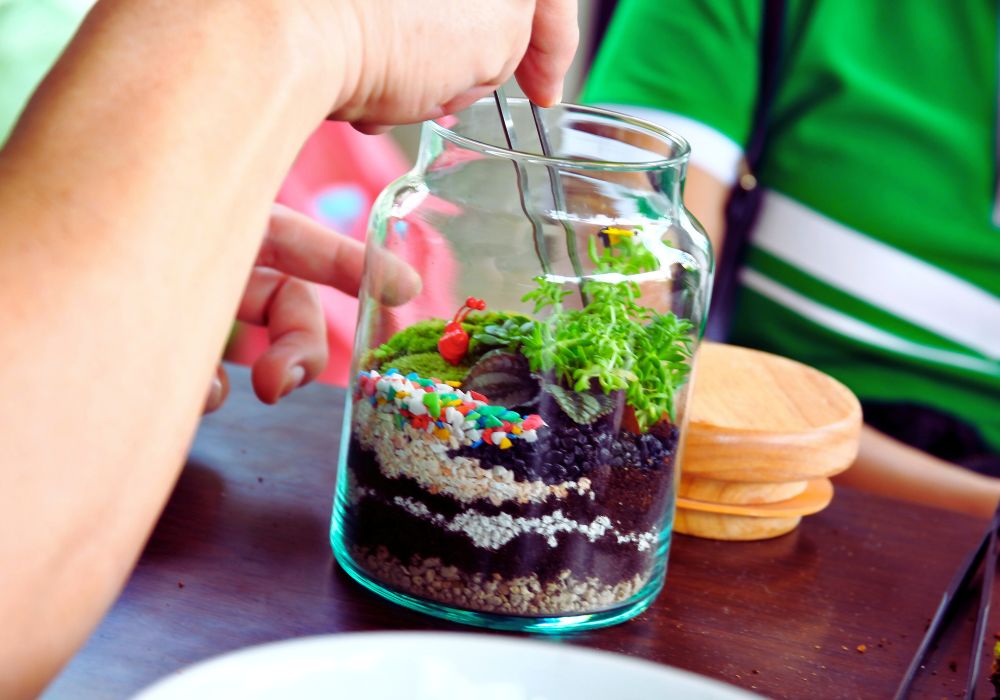Terrariums as a Fun Winter Project for Families
Share
Who wasn’t fascinated by the concept of terrariums as a child? The fact that you could put some baby plants—maybe even some worms!—and a bit of soil and water into a jar, screw on a lid, and leave it alone for a while … and not have it die? Mind blown!

How was that even possible? Science, that’s how. And that was the lesson we learned in school. These self-sustaining ecosystems were a bit like our own planet, our teachers said, recycling gases and water and allowing life to carry on. We created our own terrariums at home, with varying degrees of success. But it was fun, wasn’t it?
Now, why haven’t we made one with our own kids? It’s a fun project for winter break, with plants and accessories (maybe even the worms) easily accessible at the local garden center. Add in the fact that it doesn’t take a lot of space on your weekly to-do list, and that’s a winner of a weekend family activity. And you’ll get a nice bit of living décor out of it, too.
Start with the Container
A contributor to our less-than-successful terrariums from childhood was the strict adherence to keeping the container a completely closed system. Terrarium protocols have loosened over the decades and now containers with small openings are commonplace as they offer a better chance at success. This helps to decrease moisture inside the container, and also opens up the plant possibilities to those that prefer drier conditions such as succulents.

A “must” for a terrarium container is that it has clear walls so you can keep an eye on plant growth. It also lets the beauty of the plants shine through. The container should also be light enough to carry to a sink or outside if transporting it is necessary.
Container style is up to you. Glass jars or bowls are easy to find, especially if you opt for an open top. Flip-top lid styles are popular for closed terrariums. But get creative! Find a cloche with a fitted bottom, a vintage clear teapot, hurricane glass, an old lantern, an aquarium up in the attic! Top or not, if it’s clear and interesting you can turn it into a terrarium.

Pick Out Your Terrarium Plants
The ideal plants for your terrarium are those that are small in leaf size and stature and grow slowly. If you have a closed-top terrarium, the plants should tolerate humid environments. With an open top, you’ll have more flexibility around moisture tolerance. Keep in mind, however, that terrariums usually do not have drainage holes, so your plants’ roots may need to bear some soil moisture.
If you are including more than one type of plant, be sure all the different plants have similar growing conditions. That goes for light, moisture, nutrition, and growth habit. And if you are combining different plants, include a variety of textures and colors to make the terrarium something really cool to see. The more interesting it is, the more your kids will enjoy being involved!
Some of the more popular and appropriate plants include:
- For open (drier) terrariums: Succulents and cacti such as echeveria, haworthia, air plants, and jade plants.
- For closed (more moist) terrariums: Ferns, moss, fittonia, baby tears, and other small-statured plants.
Soils for Terrariums
The kind of soil you use in your terrarium depends on the type of terrarium (open vs. closed) and the plants you choose. Our Premium Blend Potting Soil is a moisture-retentive blend that works well in a closed terrarium. With its compost and earthworm castings, Premium Blend works well with houseplants and tropicals of all sorts.
Our Cactus & Succulent Blend is ideal for those plants that prefer drier soils. It’s a fast-draining mix that’ll treat your cacti and succulents right.
While we’re on the topic of our products, let’s include our Pure Rice Hulls as a terrarium ingredient, too. We love it as a fungus gnat deterrent, which is especially important in a moist environment such as a closed terrarium. Just sprinkle a half-inch or so on top of the soil surface and that will keep those pesky gnats at bay.
Let’s Decorate Your Terrarium!
Plants and soils are the educational stuff about terrariums that kids should be taught, but let’s make this weekend winter activity FUN for kids. Let’s decorate! Adding some decorations to the container gives it a personal touch and says, “this terrarium is mine.”

Ways to decorate a terrarium include:
Pebbles and sand: Add a base layer of pebbles or sand on top of the soil. Our latest product, 2nd Sand, is a great product for use in terrariums. It’s a beautiful crushed reclaimed glass product that is the shape, size, and texture of sand. And it’s available in three different colors, too—cobalt blue, emerald green and clear white. Add some sparkle to your terrarium!


Driftwood: Aged and tumbled wood and even small sticks are the perfect accents for those terrariums featuring succulents and cacti.
Moss: You can use moss as a plant, but it’s also cool to use it as a decorative element as it comes in different colors and textures.
Rocks and crystals: Now we’re talking fun! Use sparkling geodes and crystals for color, contrast and sparkle. Using crystals is a great entry point for kids to include other fun things like miniature figurines of sorcerers, dragons, elves and others. Hey, why not!
Creating terrariums is a fun and engaging activity for the whole family. And it goes way beyond the weekend, too. Once complete, it becomes an active memory of fun family times while also serving as lush living décor. Watching the plants grow and change—and survive!—over time is so very rewarding, and it offers a bit of gardening activity when it’s too cold to be active outdoors. It’s a fun creative project that’ll be reminders of joy and memories long after the weather has warmed.



